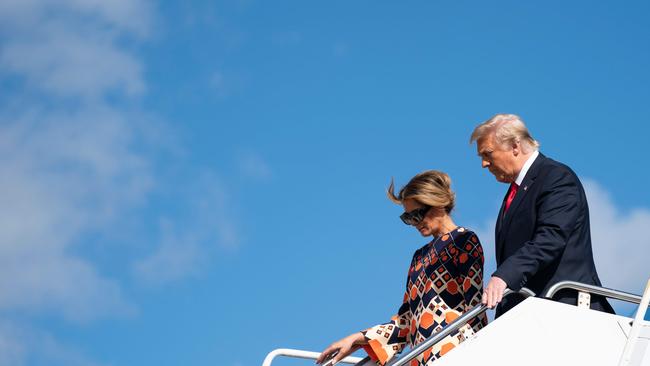
Putting aside the characteristic exaggeration, his four years in office notched up significant achievements, arguably more than his predecessor, Barack Obama, who had twice the time.
Trump ended his tenure the most unpopular president in history, denying the clear result of the November US election and facing accusations of inciting violence. But for typical Americans, his presidency was a relatively prosperous period until COVID struck.
The new White House staff quickly took down a long document their predecessors had put together on the outgoing administration’s achievements.
Some of them were controversial, such as building 650km of wall with Mexico and moving the US embassy in Israel to Jerusalem, but many were unambiguously good, if rarely reported by a media which largely disdains Trump.
The unemployment rate fell to 3.5 per cent on his watch, a level unimaginable in Australia and the lowest in the US since the 1960s.
Incomes of ordinary American households, perhaps the most important metric of all, had stagnated for decades, but they increased by $US6000 ($7750) over Trump’s tenure, more than five times as much as they had under Obama.
Moreover, these gains were greatest among black and Hispanic Americans, who earn the least.
Prescription drug prices fell nearly 10 per cent, the first decline in half a century, while the typical US household save $US2500 a year on electricity and petrol.
Remarkably, 56 per cent of Americans, even in October, told a Gallup poll they were better off than four years previously.
Joe Biden’s challenge will be to maintain these trends, which stand out amid the ongoing stagnation of real incomes in Europe — and, indeed, in Australia.
Abroad, Trump didn’t launch any wars, and brokered a peace deal between Israel and Arab states; and the meeting with North Korea’s leader and tearing up the nuclear deal with Iran haven’t turned out to be the disasters many expected.
Few experts expect Biden to substantively alter the tough line Trump took on China.
Inequality, the bane of US society, even declined. “The share of total wealth held by the bottom half of households increased, while the share held by the top 1 per cent decreased,” the former White House noted.
It was the virus that finished off Trump, not the Democrats, or even Trump’s own repulsive personality. Until the pandemic struck, if not great, America was better, at least. The vast bulk of people don’t care for the political “narratives” constructed by the media and political elites, they simply want higher wages and cheaper goods and services, and to get on with their life.
Biden is now working furiously to “defeat” the virus that ensured his victory.
His first flurry of executive orders included mask mandates for federal property and interstate travel, and new quarantine rules for arrivals in the US.
Tough rules in Europe haven’t stopped renewed outbreaks. The relationship between individual US states’ public health measures and their COVID-19 outcomes is weak, putting it generously. North Dakota mandated masks early; South Dakota didn’t, yet the trajectory of the virus has been similar in both. California locked down early and hard, yet is doing worse than Florida, which didn’t.
Governments might have less control over the path of the virus than they, and voters, think.
Based on what happened last year in the northern hemisphere, the coronavirus is likely to retreat when the winter passes — a phenomenon that many in Biden’s America will attribute, no doubt, to face masks and a more “caring” administration.
In any case, the perception that Trump’s record on COVID-19 was uniquely disastrous is unfair.
The US has “done better” (in terms of having fewer lives lost per capita) than Italy and the UK, for instance, whose governments have not been criticised anywhere near as much.
The US has conducted almost 300 million tests, more than the EU countries combined. The Trump administration introduced a travel ban on Chinese arrivals around the same time as Australia did. It increased production of ventilators, hospital beds and masks dramatically.
And despite being ridiculed in the middle of last year for claiming a vaccine was imminent, Pfizer and Moderna developed one in nine months, five times faster than any previous US vaccine.
Trump’s initial instinct to play down the severity of COVID-19 might even be come to be seen as a more rational strategy, from the point of view of overall wellbeing, than deliberately scaring the daylights out of everyone at huge social and economic cost.
Trump didn’t have much control anyway. As Australians are now well aware, in a federation the national government does not always get its way. The US states are even more independent, both financially and constitutionally, than ours. Texas has more people than Australia.
Biden should be careful not to derail the rapid US recovery. In the third quarter of last year, the US economy grew at an annualised rate of 33 per cent: the most rapid GDP growth ever recorded. More than half the jobs destroyed by lockdowns have come back.
Politically, Trump is an easy act to follow. Economically, Biden has more of a challenge.




“Amazing by any standards” was outgoing president Donald Trump’s summation of his administration’s achievements when he departed the White House.